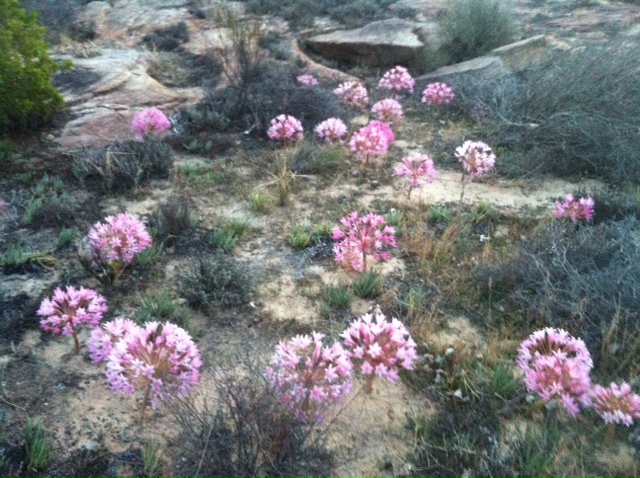Following the rooibos harvest, late summer is a time for preparing rooibos fields for planting in winter. Its time for carefully measuring what nutrients the fields may need, applying lime, applying organic fertilisers and compost, ripping, ploughing and getting ready.
In late March and into April, if you’re lucky, you can spot patches of Brunsvigia orientalis growing nearby to some of Klipopmekaar’s rooibos fields.
Brunsvigia orientalis – also known as Candelabra Flower and Maartblom (‘March Flower’ in Afrikaans) – is one of the exciting surprises experienced in the late summer at Klipopmekaar.
The emergence of large pinkish bulbs suddenly pushing their way above ground in March and April, and then very quickly elongating and becoming topped with spectacular red spherical flowerheads, is a sight to behold. What makes them even more surprising is that they pop up out of the bare ground, normally without a leaf in sight!
Their common names include: candelabra flower, king candelabra, chandelier lily, chandelier plant (Eng.), ajuinbol, koningskandelaarblom, kandelaarblom, kandelaarlelie, lantanter, Maartblom, marsblom, perdespookbossie, rolbossie, seeroogblom and tanteletant (Afr.)
Description
A large bulbous perennial from which flowers emerge between February and March. The flowerhead forms a huge sphere, up to 600 mm in diameter, with between 20 to 80 flowers. These are large, 6-tepalled, pink to red and are soon followed by the 3-sided seed capsules.
The leaves appear from about May, after the flowerhead has dried and broken off. There are generally 6 large tongue-shaped leaves spread flat on the ground. The margins are often fringed. Leaves start to die down from about October and the bulb lies dormant during summer.
Distribution
These plants occur on from southern Namaqualand to the Cape Peninsula and Plettenberg Bay.
Derivation of name and historical aspects
The genus Brunsvigia honours the House of Brunswick.
The common name kandelaarblom was first noted in about 1750. Many of the common names refer to the candelabra-like inflorescence and have been extended to several other species in the family with a similar appearance.
Some of the names refer to flowering time, while others such as rolbossie and perdespookbossie refer to the inflorescence which tumbles (rol) along and which may spook horses (perde) in so doing!
Apparently if you stared long enough at the flower you got sore eyes, hence the name sore-eye flower! A more likely explanation is that pollen in the eyes would account for the irritation. Hesse reported that the very first kandelaarsbloem to flower in Europe was in the Academy Garden of Helmstad, but no date is given.
Seed Ecology
The candelabra flower, like many other amaryllids, has adapted to the dry period of the year by resting underground in the form of a large bulb. In the Western Cape the dry season is summer. All above-ground parts dry out during this time to help prevent moisture loss through transpiration. Just before the rainy season is due to start the huge flowerhead appears.
Birds, including sunbirds, are the chief pollinators. They perch on the sturdy flower stems, receiving a reward of nectar for their pollination activities.
Once the seed begins to develop the flower stalks elongate and the inflorescence dries out. The dry flower stalks snap off and the wind sends the spherical heads tumbling along. The tips of the inflorescence containing the seeds break off, so spreading them. They are fleshy, with a very short viability period, and germinate immediately. Seeds may even germinate while still on the flowerhead. This strategy allows the seedling a full rainy season to develop sufficiently to withstand its first dry period underground.
Leaves usually appear well after the flowers. Because both the inflorescence and the leaves lose relatively large amounts of moisture, this adaptation prevents large quantities of moisture being lost at any one time, reducing stress on the plants.
The above information about Brusvigia orientalis has been sourced from the South African National Biodiversity Institute, South Africa.

